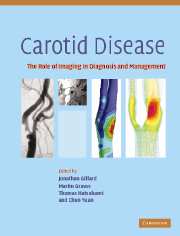Book contents
- Frontmatter
- Contents
- List of contributors
- List of abbreviations
- Introduction
- Background
- Luminal imaging techniques
- Morphological plaque imaging
- Functional plaque imaging
- Plaque modelling
- Monitoring the local and distal effects of carotid interventions
- 25 Transcranial Doppler monitoring
- 26 Imaging carotid disease: MR and CT perfusion
- 27 Near infrared spectroscopy in carotid endarterectomy
- 28 Single photon emission computed tomography (SPECT)
- 29 Monitoring carotid interventions with xenon CT
- Monitoring pharmaceutical interventions
- Future directions in carotid plaque imaging
- Index
- References
29 - Monitoring carotid interventions with xenon CT
from Monitoring the local and distal effects of carotid interventions
Published online by Cambridge University Press: 03 December 2009
- Frontmatter
- Contents
- List of contributors
- List of abbreviations
- Introduction
- Background
- Luminal imaging techniques
- Morphological plaque imaging
- Functional plaque imaging
- Plaque modelling
- Monitoring the local and distal effects of carotid interventions
- 25 Transcranial Doppler monitoring
- 26 Imaging carotid disease: MR and CT perfusion
- 27 Near infrared spectroscopy in carotid endarterectomy
- 28 Single photon emission computed tomography (SPECT)
- 29 Monitoring carotid interventions with xenon CT
- Monitoring pharmaceutical interventions
- Future directions in carotid plaque imaging
- Index
- References
Summary
Introduction
Our knowledge of cerebral hemodynamics during carotid occlusion is derived from several pathophysiologically different clinical situations understood via myriad imaging and assessment modalities. This leads to what, at the outset, seems to be a vast and conflicting body of literature regarding the field. Our goal here is first, to carefully explore the physiologic information gained in these various clinical situations and second, to apply these principles, in so far as the available evidence allows, to patient care. It is important to understand that each of these disparate situations and technologies seek to offer some insight into the large picture of how cerebral blood flow (CBF) responds to various challenges. By focusing too closely on the minutia of any particular situation or technology without incorporating the alternate perspectives offered by other situations or technologies, one runs the risk of losing understanding of this larger picture.
There are two clinical scenarios in which we have gained our most extensive understanding of cerebral hemodynamics in relation to carotid occlusion. One is when the carotid artery is intentionally occluded as a test of tolerance to permanent occlusion (balloon test occlusion or BTO). The other involves the study of patients that present with chronic carotid occlusion who are objects of study in order to assess their risk for future stroke. Patients undergoing BTO are initially asymptomatic and temporary occlusion of the carotid provides the most “pure” study of cerebral hemodynamics – i.e. the physiological response to an abrupt carotid occlusion.
Keywords
- Type
- Chapter
- Information
- Carotid DiseaseThe Role of Imaging in Diagnosis and Management, pp. 396 - 417Publisher: Cambridge University PressPrint publication year: 2006
References
- 2
- Cited by

